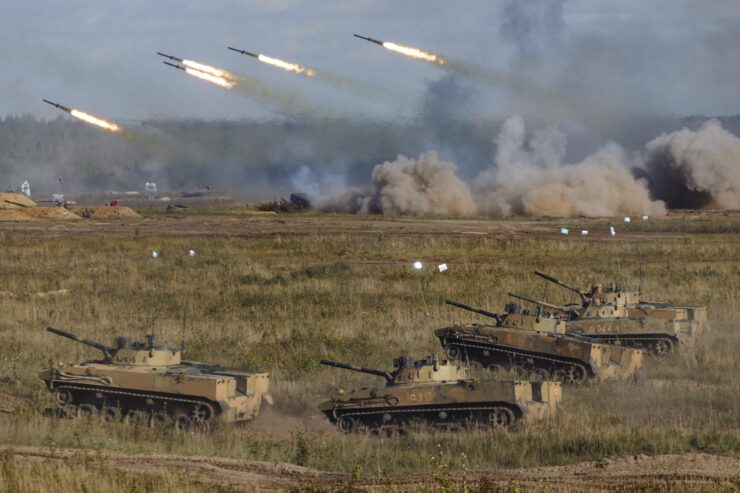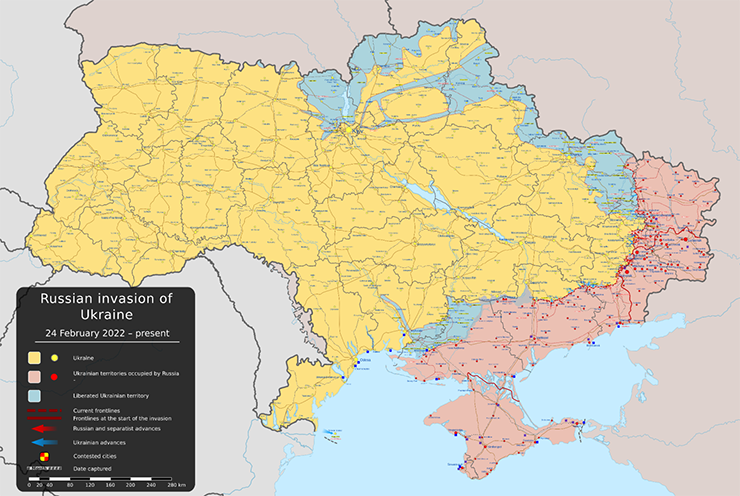
In the wake of the Russia-Ukraine conflict and the subsequent imposition of sanctions by Western nations, the global business landscape has experienced seismic shifts. The conflict’s far-reaching impacts have sparked a series of complex outcomes that have rippled through various industries, prompting strategic realignments, economic turbulence, and geopolitical repercussions.
As Western countries levied sanctions against Russia in response to the Ukraine crisis, a vacuum emerged in the commodities market. This vacuum presented a unique opening for Indian companies to step in as alternative suppliers. With a history of technological collaboration and longstanding ties between India and Russia, Indian businesses swiftly capitalised on this opportunity. This strategic manoeuvre not only bolstered India’s export capabilities but also strengthened the trade partnership between the two nations.
The Exodus and Relocation
The Russian invasion and the subsequent geopolitical instability prompted many international companies to rethink their ties with Russia. Faced with the uncertainty of the conflict’s outcome and the potential for prolonged sanctions, businesses found refuge in India’s relatively stable market. This relocation trend marked a significant shift, as companies sought safe havens for their operations and investments. India, with its robust technological ecosystem and growing economic prowess, emerged as an attractive hub for businesses seeking stability amidst global turmoil.
A Dual-edged Energy Sword
While the war disrupted global energy markets, triggering a surge in energy prices, its effects were not unilaterally positive for all businesses. Indian industries encountered challenges as rising energy costs led to an immediate impact on production expenses. The resultant decrease in profit margins put pressure on investments, translating to an overall escalation of business risk. This energy-related conundrum exemplified the interconnectedness of global economies and underscored the need for diversified strategies.
Supply Chain Woes
Supply chain disruptions, exacerbated by the Ukraine conflict and the lingering chip shortage, unveiled a new layer of complexity for Indian businesses. The inability to access crucial raw materials and components disrupted production timelines, causing shortages and surging costs. These disruptions amplified uncertainties and underscored the fragility of global supply chains. Concurrently, the heightened geopolitical risks arising from the war created an environment of unpredictability. Businesses found themselves grappling with the challenge of planning for an uncertain future, as political landscapes remained volatile and difficult to anticipate.
A Mosaic of Misinformation and Fallout
As misinformation spread in the aftermath of the conflict, the true casualty figures and the motivations behind the war became increasingly obscured. The war’s true causes, whether rooted in self-defence or geopolitical ambitions, became a matter of perspective. The business world, too, grappled with its own version of ambiguity. Sanctions impacted Russian and Ukrainian businesses, causing lasting damage. In the United States, concerns about food security arose, particularly surrounding wheat and processed foods. Europe experienced the ripple effect of rising energy costs, contributing to inflationary pressures. Meanwhile, in Asia, China and India played pivotal roles, with India benefiting from the shift in manufacturing from China due to the combined impacts of the invasion and the effective COVID control.
Chronicle of the Conflict
January 6, 2022: Kazakhstan’s shift to electronic trading for LPG resulted in a 100% price surge, prompting nationwide protests and a state of emergency. Responding to President Tokayev’s plea for assistance to the Collective Security Treaty Organization, Russia, Armenia, Belarus, Kyrgyzstan, and Tajikistan dispatched troops to Kazakhstan, underscoring the far-reaching impact of regional dynamics.
January 7, 2022: The US dismissed Russia’s three demands:
- A stance against NATO expansion, particularly towards Ukraine
- A prohibition of US weaponry near the Russian border
- A return to the pan-European security framework adopted by the Organization for Security and Cooperation in Europe in the late 1990s. (This framework aimed to uphold a mutual recognition of European nations’ security interdependence, including Russia, and a commitment to prevent disruption via NATO expansion).
January 17, 2022: Russian troops entered Belarus for military training, a move further intertwining regional alliances amidst escalating tensions.
January 19, 2022: The US extended $200 million in military aid to Ukraine. President Biden, at a press conference, emphasised holding Russia accountable for potential invasions. He noted that responses could differ based on the scale and nature of such actions.
January 24, 2022: NATO forces were placed on standby, reflecting heightened global apprehension regarding the brewing conflict.
January 25, 2022: Near Crimea, Russian military exercises involving 6,000 troops and 60 fighter jets signified heightened preparation.
February 2, 2022: Ukrainian Foreign Minister Dmytro Kuleba closed the door on a federal Ukraine with regional cultural protections for the Russian-speaking population. This decision marked a pivotal moment in the search for an end to the conflict.
February 7, 2022: Amidst mounting tensions, US President Biden pledged to halt Nord Stream 2 gas pipeline should Russia proceed with invasion plans. Meanwhile, during his Moscow visit, Emmanuel Macron reaffirmed his commitment to the Minsk Accords, agreements aiming to resolve the Donbas conflict between Russia and Ukraine.
February 10, 2022: Russia and Belarus embarked on a 10-day military exercise, underscoring strategic collaboration between the two nations.
February 11, 2022: Political advisors from the “Normandy format” nations convened in Berlin, but discussions concluded without concrete results. Vladimir Putin criticised unfulfilled promises and a lack of commitment from Western leaders.
February 15, 2022: German Foreign Minister Annalena Baerbock declared Germany’s willingness to no longer obstruct Ukraine’s NATO-membership, marking a significant shift in the region’s dynamics. Meanwhile, the Russian parliament’s request for Putin to acknowledge Donetsk and Luhansk’s independence was met with his refusal.
February 17, 2022: US President Biden’s announcement of an imminent Russian attack on Ukraine sparked a dramatic escalation, leading to increased bombardment of the Donbass population.
February 19, 2022: Ukrainian President Zelensky signalled a potential return to nuclear armament, unless the US honoured guarantees of protection outlined in the Budapest Memo. Urging international cooperation, Zelensky proposed a summit conference of the Budapest Memorandum’s signatories.
February 21, 2022: Putin’s address outlined the complexity of the situation, invoking the concept of “Responsibility to Protect” (R2P) and foreseeing potential sanctions regardless of the scale of intervention. He recognised the independence of the Donbass republics, paving the way for treaties of friendship and assistance.
February 23, 2022: The Donbass republics sought military aid from Russia, deepening alliances in a rapidly evolving environment.
February 24, 2022: Citing Article 51 (Self-defence) of the United Nations Charter, Vladimir Putin initiated the invasion of Ukraine, invoking mutual military assistance within a defensive alliance framework.
February 27, 2022: Ukraine agreed to engage in talks with Russia. The European Union’s decision to allocate 450 million Euros for arms supply to Ukraine marked an unprecedented step. Putin ordered Russian army “deterrence forces” into combat mode, citing aggressive statements from NATO countries’ officials.
March 5, 2022: Ukrainian negotiator Denis Kireyev was assassinated by the Ukrainian secret service (SBU), underscoring the high stakes of diplomatic engagements.
March 10, 2022: Dmitry Demyanenko, an advocate for a Russian agreement, was assassinated by the Mirotvorets militia, further highlighting the perilous complexities surrounding the conflict.
Since the start of 2022, Ukraine has received a staggering $171.5 billion from over 50 countries. This financial support has been allocated across various sectors: $75.32 billion for financial assistance, $14.93 billion for humanitarian aid, and $81.26 billion for military resources. These funds have flowed into Ukraine between January 2022 and May 2023, providing critical backing during this tumultuous period. In contrast, Russia has faced sanctions from the US, Canada, and the EU, adding another layer of complexity to the ongoing situation.
Losses on Each Side
Given the highly diverse nature of the data, it becomes imperative to consider estimates from all three sources: Ukraine, Russian, and US, in order to gain a comprehensive understanding of the situation.
Ukraine

Russia


Final Thoughts
In the grand narrative of the Russia-Ukraine conflict, both nations have faced losses that transcended military victories. The collateral damage extended to their people and global implications. Similarly, businesses, whether directly or indirectly involved, have felt the reverberations of this turmoil. The combination of sanctions, geopolitical shifts, and economic challenges has cast a lingering shadow over the corporate world. The long-term implications of these events necessitate adaptive strategies, a renewed focus on diversification, and a heightened awareness of the volatility inherent in modern geopolitics.
References
- https://www.understandingwar.org/backgrounder/ukraine-conflict-updates
- https://www.oryxspioenkop.com/2022/02/attack-on-europe-documenting-equipment.html
- https://www.occrp.org/en/the-pandora-papers/pandora-papers-reveal-offshore-holdings-of-ukrainian-president-and-his-inner-circle
- https://www.pravda.com.ua/eng/
- https://en.wikipedia.org/wiki/Casualties_of_the_Russo-Ukrainian_War#cite_note-42K-76
- https://www.usnews.com/news/world/articles/2023-01-17/over-9-000-civilians-killed-in-ukraine-since-russia-invaded-kyiv
- https://www.ukrinform.net/rubric-ato/3650080-more-than-16500-people-killed-in-ukraine-due-to-russian-aggression.html
- https://www.foxnews.com/world/russian-invasion-kills-42k-ukrainian-civilians-since-start-war-us-officials-say
- https://www.ukrinform.net/rubric-ato/3626014-presidents-office-says-ukrainian-army-lost-up-to-13000-soldiers-since-war-started.html
- https://en.zona.media/article/2022/05/11/casualties_eng
-The writer is a student of Integrated BBA-MBA, Institute of Management, Nirma University. The views expressed are personal and do not necessarily reflect the views of Raksha Anirveda













